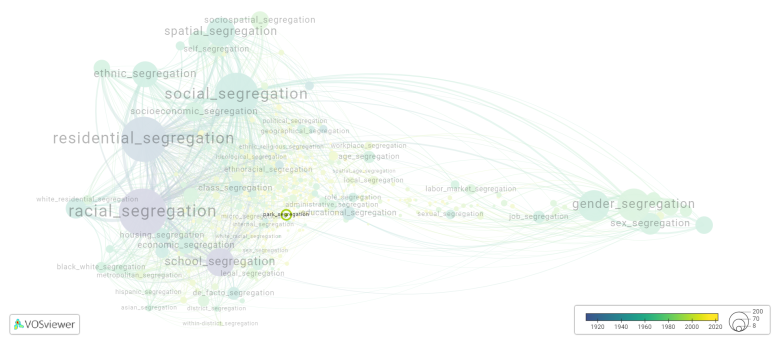Park segregation: Difference between revisions
(Creating page) |
(Creating page) |
||
| (6 intermediate revisions by the same user not shown) | |||
| Line 15: | Line 15: | ||
Park segregation is frequently discussed in the literature with the following segregation forms: | Park segregation is frequently discussed in the literature with the following segregation forms: | ||
[[racial segregation]], [[social segregation]], [[school segregation]] | |||
[[park_segregation.png|780x780px]] | [[File:park_segregation.png|780x780px]] | ||
For the complete network of | |||
This visualization is based on the study [[Segregation_Wiki:About| The Multidisciplinary Landscape of Segregation Research]]. | |||
year of publication https://tinyurl.com/ | |||
For the complete network of interrelated segregation forms, please refer to: | |||
* [https://tinyurl.com/2235lkhw First year of publication] | |||
* [https://tinyurl.com/2d8wg5n3 Louvain clusters] | |||
* [https://tinyurl.com/223udk5r Betweenness centrality] | |||
* [https://tinyurl.com/244d8unz Disciplines in which segregation forms first emerged (Scopus database).] | |||
==References== | ==References== | ||
==Notes== | ==Notes== | ||
Latest revision as of 07:17, 16 October 2024
Date and country of first publication[1][edit | edit source]
2007
United States
Definition[edit | edit source]
Park segregation refers to the division of public parks based on race, ethnicity, or socioeconomic status. This was a common practice in the United States during the period of segregation laws, which prohibited people of different races from using the same facilities.
In many cities, parks were designated as "whites-only" or "blacks-only" spaces, with separate facilities such as restrooms, drinking fountains, and seating areas. This segregation was a way to enforce and perpetuate racial discrimination and inequality.
Today, park segregation is illegal under civil rights laws, and public parks are considered open to everyone regardless of race or background. However, there may still be instances of segregation based on socioeconomic factors, such as the availability of amenities in wealthier neighborhoods compared to those in lower-income areas.
Efforts are being made to ensure that public parks are accessible and inclusive to all members of the community, regardless of their background. This includes creating programs and initiatives to promote diversity and inclusivity in park spaces, as well as addressing any disparities in park resources and amenities.
See also[edit | edit source]
Related segregation forms[edit | edit source]
Park segregation is frequently discussed in the literature with the following segregation forms:
racial segregation, social segregation, school segregation

This visualization is based on the study The Multidisciplinary Landscape of Segregation Research.
For the complete network of interrelated segregation forms, please refer to:
References[edit | edit source]
Notes[edit | edit source]
- ↑ Date and country of first publication as informed by the Scopus database (December 2023).
At its current state, this definition has been generated by a Large Language Model (LLM) so far without review by an independent researcher or a member of the curating team of segregation experts that keep the Segregation Wiki online. While we strive for accuracy, we cannot guarantee its reliability, completeness and timeliness. Please use this content with caution and verify information as needed. Also, feel free to improve on the definition as you see fit, including the use of references and other informational resources. We value your input in enhancing the quality and accuracy of the definitions of segregation forms collectively offered in the Segregation Wiki ©.
Park segregation appears in the following literature[edit | edit source]
O'Brien W. (2007). The strange career of a Florida State Park: Uncovering a Jim Crow past. Historical Geography, 35(), 160-184. https://doi.org/
O'Brien W.E. (2012). State parks and Jim crow in the decade before brown V. board of education. Geographical Review, 102(2), 166-179. https://doi.org/10.1111/j.1931-0846.2012.00141.x
Retzlaff R. (2021). Desegregation of City Parks and the Civil Rights Movement: The Case of Oak Park in Montgomery, Alabama. Journal of Urban History, 47(4), 715-752. SAGE Publications Inc..https://doi.org/10.1177/0096144219877636
